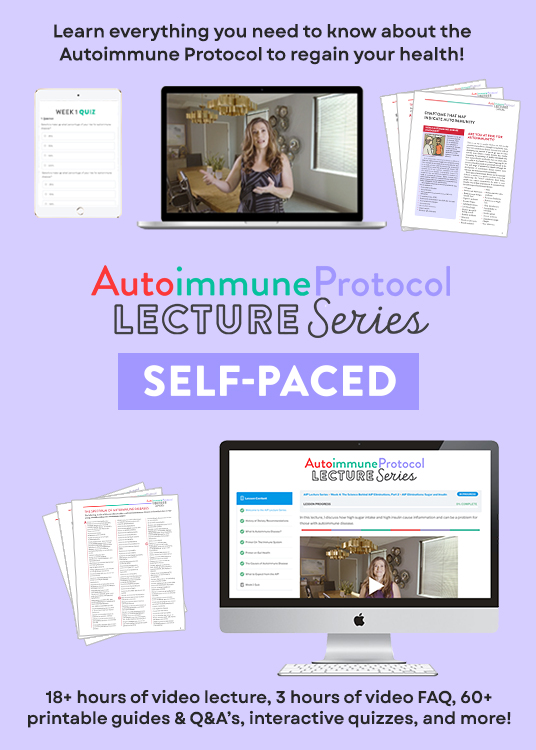On this week’s episode, Stacy and Sarah address a listener’s question on the role that exercise has on metabolism. Sarah shares the extensive research on this subject and breaks down the findings. Stacy reflects on her weight loss journey and the point she eventually reached. And both hosts highlight the key to any fruitful exercise regimen.
If you enjoy the show, please review it on iTunes!
The Paleo View (TPV), Episode 389: How do I optimize calories out?
Welcome back to episode 389 of The Paleo View! (0:40)
Stacy is human again and excited to dive into this week’s topic.
Sarah is feeling very fortunate to have maintained her health during this nasty cold and flu season.
Stacy is thrilled that her recovery was a quick one.
Matt graduated from Postal Academy first in his class and Stacy is feeling so proud of him.
It has been a new world for Stacy and the boys as they all adjust to Matt working out of the house.
Sarah and Stacy took a brief walk down memory lane, remembering the moments from their childhood when their mothers would break out into songs.
What Inspired this Show
This week’s episode was inspired by a listener’s question and came from a woman who attended one of Sarah’s workshops last year.
Save 70% Off the AIP Lecture Series!
Learn everything you need to know about the Autoimmune Protocol to regain your health!
I am loving this AIP course and all the information I am receiving. The amount of work you have put into this is amazing and greatly, GREATLY, appreciated. Thank you so much. Taking this course gives me the knowledge I need to understand why my body is doing what it is doing and reinforces my determination to continue along this dietary path to heal it. Invaluable!
Carmen Maier

It is a follow-up question from the healthy weight-loss session that Sarah hosted.
The entire session is available as an online course on Sarah’s site.
It has a focus on not just how to lose weight, but how to lose weight in a healthy way so that it is easy to maintain that loss.
The science tells us that every weight loss diet is effective.
The trick is that maintaining that weight loss for the vast majority of these diets is flawed in that they are designed to eventually make us fail.
Most weight-loss diets will result in two things.
One is the reduction of our basil metabolic rate, which means we need fewer calories and burn fewer calories at rest.
And two, ghrelin (our hunger hormone) is increasing.
So we need fewer calories to keep going on our weight-loss journey, but we are getting hungrier and hungrier.
Instinct kicks in and you can’t muscle through that situation forever.
This is when most people end up yo-yoing.
Sarah’s online course was designed to bust a lot of diet myths, as well as set the groundwork for understanding how to set smart goals and structure diet and lifestyle and lose weight in a sustainable way.
This question from Lauren is a follow-up question to that information.
Q&A
Lauren says (14:10):
I went to The Paleo Mom’s workshop in February 2019 and it was lovely.
At the workshop, we talked about working out and hunger hormones.
When we talk about exercise and weight loss, is there science behind high-intensity workouts that you burn calories throughout the day (after the workout) if the workout is intense enough?
OR do you simply burn the calories DURING the workout and it stops there?
I’ve read that there isn’t much science behind this theory (but I think it may be a hypothesis?!)
Sarah is very excited to answer this question because there is a lot of science on this.
A hypothesis is not just a guess.
You look at what is currently known and either work to explain what is happening, or expand what is known by predicting what will happen if the conditions right.
Sarah broke down the difference between a hypothesis and a theory.
There are a couple of studies now that show that if you achieve the same caloric deficit over time, we feel hungrier and that hunger magnifies over time.
Whereas when you achieve that same level of caloric deficit through exercise, our hunger is the same as if we didn’t have a caloric deficit.
This is a very important thing to know in terms of weight loss.
Diet is important from a lean muscle mass preservation effect and from a nutrients for supporting metabolism as we are burning fat.
The research published in 2016 on the Big Loser contestants that proved how problematic this dual effect is.
The more physically active those contestants were after the season had ended, the more likely they were to maintain their weight loss.
Exercise provides this interesting benefit to hunger, but there is more to it than that.
Losing weight is not as simple as calories in versus calories out, but calories do matter.
A caloric deficit is required to lose weight.
Where exercise comes into play in addition to helping to regulate hunger through weight loss, is hormone regulation.
It improves insulin sensitivity, preserves lean muscle mass, a metabolic boost is stimulated, and exercise has been known to improve the gut microbiome composition.
The pieces mentioned above have been broken down throughout the history of this show.
Please reference these previous episodes for more information:
- 140: THE DANGER OF KETOGENIC DIETS
- 195: THE LATEST IN WEIGHT LOSS RESEARCH
- 196: THE OBESITY PARADOX
- 197: CARBOHYDRATE INSULIN HYPOTHESIS
- 198: WEIGHT LOSS FOLLOW UP
- 305: WHY INSULIN IS IMPORTANT & AWESOME!
- 353: BEACH BODY YO-YO
- 386: INTERMITTENT FASTING
More on Exercise
Generally, exercise that has been traditionally viewed as cardio, generally results in more calories burned per hour when we are doing it. (28:16)
There are some exceptions, like when very heavy weight lifting can burn as many calories as running.
However, there is a lot more data on cardio available.
Any time that you add load (like hiking with a backpack), burns way more calories than hiking without.
How many calories you burn in a workout is dependent on a number of things.
Overall, on average, cardio burns more than traditional strength training activities, with the exception of weight lifting at a very intense level.
There is a vast body of research showing that we do get a metabolic boost that can last hours after exercise.
How high the boost is, is typically related to how intense the exercise is.
How long it lasts, is related to the duration.
In the last few years, there have been studies that have been trying to expand on these understandings.
Some studies have shown that short bursts of activity can have a really dramatic boost on our metabolism after we are done exercising.
One study, in particular, looked at two-minute sprints on a stationary bicycle, with three-minute rest periods in between.
The same participants either did one, two, or three of these circuits.
The study showed that they had a significantly increased metabolism.
If they did three of those two-minute sprints, their metabolism stayed elevated for four hours afterward.
There is definitely an impact based on how much we do, but there is a boost no matter what.
There was another study where cyclists worked at approximately 80% of their VO2 max (which is a heavy workload) for 45-minutes.
These participants had a metabolic boost that lasted 14-hours.
Most studies show that by 24-hours later, our metabolism returns to normal.
However, there was a study that looked at 80-minutes of cycling at 70-75 VO2 max, and their metabolism was still 5% higher than their BMR 24-hours later.
Strength Training
There have been some really interesting studies looking at circuit training.
The boost in our metabolism that we get from strength-training appears to last a lot longer than the boost that we get from cardio.
Studies have shown a range in metabolic boost from weight-lifting ranging from 16-hours, to 24hours, and even up to 38-hours.
Sarah broke down the studies in greater detail, showing how the results vary based on how the study is structured.
When we do strength training, there seems to be a much longer tail in terms of how long metabolism lasts.
There have even been studies that have compared circuit training to treadmill training.
They have shown that the initial level is higher from resistance training.
The metabolic boost from weight lifting is higher and lasts longer.
This makes a fairly strong case for the metabolic benefits for weight-lifting, resistance-type training.
In addition, over time this increases the basal metabolic rate through building more muscle.
Overall, Sarah thinks it is a great idea to do both.
Sarah found a few of the studies looking at volume to be particularly interesting (39:13).
After reviewing the findings, Sarah feels that there isn’t yet enough information to tell if more volume or more intensity equals a bigger metabolic boost.
Combining the Two Forms of Training
There are a couple of studies showing that if you do cardio first and then your resistance training, you actually burn more calories during your workout.
Doing the same amount of work, the difference is substantial.
Sarah again broke down the details of the research into greater detail.
Stacy shared her experience with picking a lane when it came to weight loss versus building strength.
You need to know what your priorities are before jumping into a routine.
Sarah wanted to highlight a key detail that we are talking about relatively small differences over the course of 24-hours.
It is most important to set yourself up with an activity that you like that you are most likely to stick with.
You need to feel good about it, and your body needs to like it.
It is also very important to keep your intensity and your sport at something that is sustainable.
Exercise is an important component of healthy weight loss, but it is also an important component of healthy living.
Stacy emphasized the importance of finding something you really enjoy doing.
It comes down to habits.
Make sure that you feel your best and are actually excited to do the exercise you have committed to doing.
A Deeper Look Into the Details
There is one more study that Sarah would like to discuss.
Interval training has been shown to provide a bigger metabolic boost.
So combining that short-burst, intense type cardio with rest periods and with strength training, definitely provides the biggest metabolic boost.
This final study found that going back and forth between cardio and resistance training did provide the highest metabolic boost that lasted the longest.
The study also confirmed what was found in previous studies, regarding the benefits of doing cardio before weight-training, versus the other way around.
Sarah found this study’s findings on perceived exertion to be very interesting as well.
The study found that the lowest perceived exertion was doing the endurance training first, and then the resistance training.
Sarah would love to see more data on this, and is actually working on a blog post on this.
The takehome is that exercise does boost your metabolism.
It will be a lot higher for depending on the type of exercise, how intense it was and how long it lasted.
This is on top of all the other benefits of exercise.
Like restoring insulin sensitivity, supporting liver health, the benefits to the gut microbiome, the hormonal impact, and so much more.
Other Ways to Boost Metabolism
There are other things that are known to boost metabolism.
Digesting protein increases your basal metabolic rate.
This is true for any diet; if there is a big caloric restriction, we are burning muscle.
The only thing that preserves muscle through weight loss is the combination of eating a high protein diet with doing some resistance training.
You can actually build more muscle through weight loss with this combo.
Eating about 30% of calories from protein has been shown to be very beneficial to both weight loss and supports the maintenance of weight loss.
Drinking a big bottle of water can also boost our metabolism.
Getting enough sleep is really important.
There is a huge link between inadequate sleep and risk of weight gain and obesity.
Closing Thoughts
The real take-home message is that exercise is important.
It is important whether or not you are trying to lose weight, maintain weight loss, or maintain your health.
One of the episodes that Stacy forgot to mention as a favorite is episode 367.
Stacy took a moment to reiterate that weight loss can be for health and it can also be for aesthetics.
If you feel like you are failing at your weight-loss goals, this might be a mental shift as well as a physical shift that is needed.
Referring back to that episode may be a great resource if you are having those feelings.
It has definitely been a journey for Stacy to reach the point where she is longer working to be thin.
Red-light therapy is one of the ways that you can both tweak how you feel mentally and physically.
When Stacy starts her day with red-light therapy, she mentally feels better.
She finds that she is prone to make better choices when she gets that boost in the morning.
If you feel like you are struggling, this might be something worth exploring.
Thank you so much for listening!
If you think someone else might be interested in this show, please share it.
Please also leave reviews so that others can find this episode.
Thank you again for listening! Stacy and Sarah will be back again next week (1:06:18).










